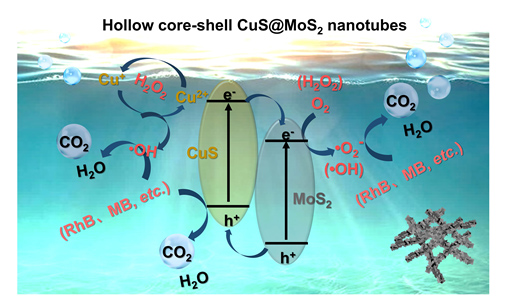[1] Deng, W.; Zhao, H.; Pan, F.; Feng, X.; Jung, B.; Abdel-Wahab, A.; Batchelor, B.; Li, Y. Environ. Sci. Technol. 2017, 51, 13372.
[2] Cheng, Y. Y.; Tsai, T. H. J. Agric. Food Chem. 2017, 65, 1078.
[3] Huang, Y.; Wang, D.; Liu, W.; Zheng, L.; Wang, Y.; Liu, X.; Fan, M.; Gong, Z. Food Chem. 2020, 316, 126378.
[4] Farshid, G.; Mahsa, M. Chem. Eng. J. 2017, 310, 41.
[5] Ma, Y.; Liu, R.; Meng, S.; Niu, L.; Yang, Z.; Lei, Z. Acta Chim. Sinica 2019, 77, 153(in Chinese). (马亚丽, 刘茹雪, 孟双艳, 牛力同, 杨志旺, 雷自强, 化学学报, 2019, 77, 153.)
[6] Yang, B.; Zhang, Y. Acta Chim. Sinica 2019, 77, 1017(in Chinese). (杨波, 张永丽, 化学学报, 2019, 77, 1017.)
[7] Hao, X.; Zou, L.; Zhang, G.; Zhang, Y. Chinese Chem. Lett. 2009, 20, 99.
[8] Hu, L.; Xu, D.; Zou, L.; Yuan, H.; Hu, X. Acta Phys.-Chim. Sin. 2015, 31, 771.
[9] Wang, S. Dyes Pigm. 2008, 76, 714.
[10] Wang, N. N.; Zheng, T.; Zhang, G. S.; Wang, P. J. Environ. Chem. Eng. 2016, 4, 762.
[11] Huang, D.; He, J.; Gu, Y.; He, F. Acta Chim. Sinica 2017, 75, 866(in Chinese). (黄丹维, 何佳, 谷亚威, 何锋, 化学学报, 2017, 75, 866.)
[12] Yu, H.; Fang, R.; Chen, S.; Zou, G. Acta Chim. Sinica 2005, 63, 1357(in Chinese). (于怀东, 方茹, 陈士明, 邹国林, 化学学报, 2005, 63, 1357.)
[13] Bokare, A. D.; Choi, W. J. Hazard. Mater. 2014, 275, 121.
[14] Bello, M. M.; Raman, A. A. A.; Asghar, A. Process Saf. Environ. Prot. 2019, 126, 119.
[15] Yang, X.; Cheng, X.; Elzatahry, A. A.; Chen, J.; Alghamdi, A.; Deng, Y. Chinese Chem. Lett. 2019, 30, 324.
[16] Marschall, R. Adv. Funct. Mater. 2014, 24, 2421.
[17] Yang, X.; Wang, D. ACS Appl. Energy Mater. 2018, 1, 6657.
[18] Yin, S.; Au, C.; Li, H. Acta Phys.-Chim. Sin. 2020, 36, 1910023(in Chinese). (尹双凤, 区泽堂, 李华明, 物理化学学报, 2020, 36, 1910023.)
[19] Pan, D.; Xiao, S.; Chen, X.; Li, R.; Cao, Y.; Zhang, D.; Pu, S.; Li, Z.; Li, G.; Li, H. Environ. Sci. Technol. 2019, 53, 3697.
[20] Zhu, S.; Chen, X.; Li, Z.; Ye, X.; Liu, Y.; Chen, Y.; Yang, L.; Chen, M.; Zhang, D.; Li, G.; Li, H. Appl. Catal. B:Environ. 2020, 264, 118515.
[21] Mady, A. H.; Baynosa, M. L.; Tuma, D.; Shim, J. J. Appl. Catal. B:Environ. 2017, 203, 416.
[22] Yuan, D.; Sun, M.; Tang, S.; Zhang, Y.; Wang, Z.; Qi, J.; Rao, Y.; Zhang, Q. Chinese Chem. Lett. 2020, 31, 547.
[23] Chen, J.; Chao, F.; Ma, X.; Zhu, Q.; Jiang, J.; Ren, J.; Guo, Y.; Lou, Y. Inorg. Chem. Commun. 2019, 104, 223.
[24] Wang, Y.; Zhang, L.; Jiu, H.; Li, N.; Sun, Y. Appl. Surf. Sci. 2014, 303, 54.
[25] Yin, X.-L.; Li, L.-L.; Liu, M.-L.; Li, D.-C.; Shang, L.; Dou, J.-M. Chem. Eng. J. 2019, 370, 305.
[26] Deng, C.; Ge, X.; Hu, H.; Yao, L.; Han, C.; Zhao, D. CrystEngComm 2014, 16, 2738.
[27] Wang, W.; Zhu, S.; Cao, Y.; Tao, Y.; Li, X.; Pan, D.; Phillips, D.; Zhang, D.; Chen, M.; Li, G.; Li, H. Adv. Func. Mater. 2019, 29, 1901958.
[28] Guo, L.; Zhang, K. L.; Han, X. X.; Zhao, Q.; Wang, D. J.; Fu, F. Nanomaterials 2019, 9, 1151.
[29] Xiao, S.; Dai, W.; Liu, X.; Pan, D.; Zou, H.; Li, G.; Zhang, G.; Su, C.; Zhang, D.; Chen, W.; Li, H. Adv. Energy Mater. 2019, 9, 1900775.
[30] Wu, C.; Yu, S.-H.; Chen, S.; Liu, G.; Liu, B. J. Mater. Chem. 2006, 16, 3326.
[31] Qiu, J.; Zheng, W.; Yuan, R.; Yue, C.; Li, D.; Liu, F.; Zhu, J. Appl. Catal. B:Environ. 2020, 264, 118514.
[32] He, Y.; Tan, Y.; Zhang, J. Acta Chim. Sinica 2014, 72, 1228(in Chinese). (何燕萍, 谭衍曦, 张健, 化学学报, 2014, 72, 1228.)
[33] Meng, N.; Zhou, Y.; Nie, W.; Song, L.; Chen, P. J. Nanopart. Res. 2015, 17, 300.
[34] Gao, Q.; Giordano, C.; Antonietti, M. Angew. Chem. Int. Ed. 2012, 51, 11740. |
